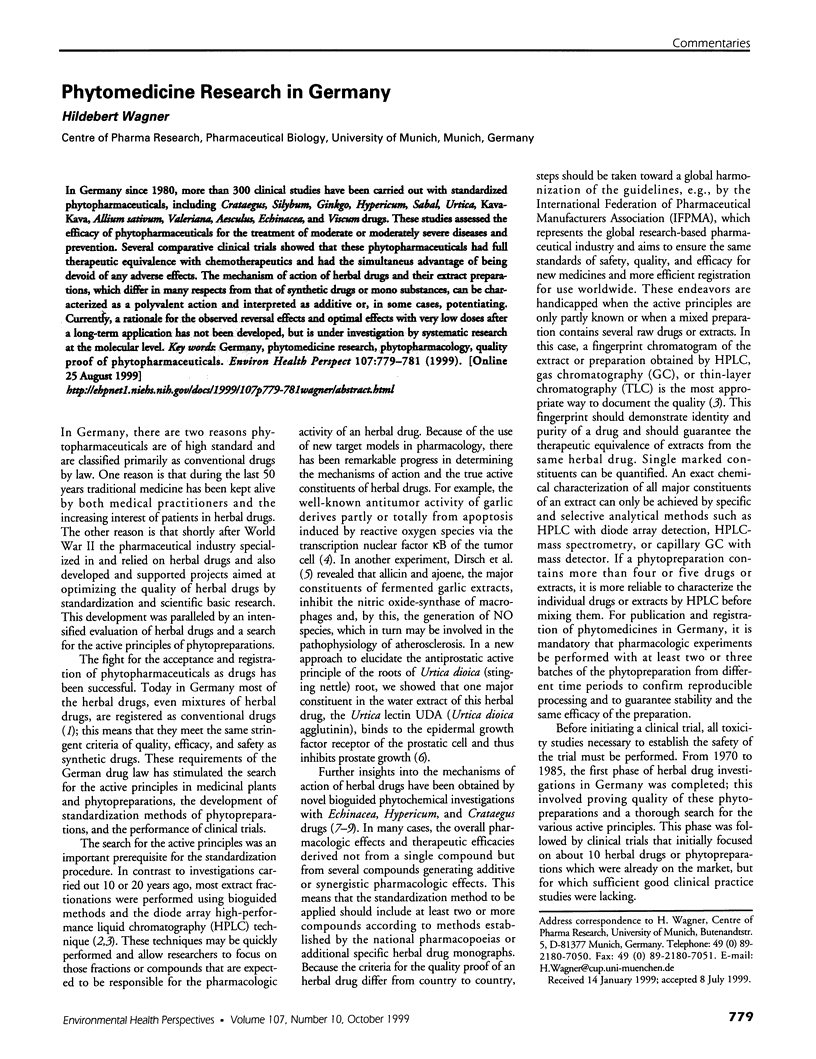Abstract
In Germany since 1980, more than 300 clinical studies have been carried out with standardized phytopharmaceuticals, including Crataegus, Silybum, Ginkgo, Hypericum, Sabal, Urtica, Kava-Kava, Allium sativum, Valeriana, Aesculus, Echinacea, and Viscum drugs. These studies assessed the efficacy of phytopharmaceuticals for the treatment of moderate or moderately severe diseases and prevention. Several comparative clinical trials showed that these phytopharmaceuticals had full therapeutic equivalence with chemotherapeutics and had the simultaneous advantage of being devoid of any adverse effects. The mechanism of action of herbal drugs and their extract preparations, which differ in many respects from that of synthetic drugs or mono substances, can be characterized as a polyvalent action and interpreted as additive or, in some cases, potentiating. Currently, a rationale for the observed reversal effects and optimal effects with very low doses after a long-term application has not been developed, but is under investigation by systematic research at the molecular level.
Full text
PDF


Selected References
These references are in PubMed. This may not be the complete list of references from this article.
- Ammon H. P., Händel M. Crataegus, Toxikologie und Pharmakologie Teil II: Pharmakodynamik. Planta Med. 1981 Nov;43(3):209–239. [PubMed] [Google Scholar]
- Ammon H. P., Händel M. Crataegus, Toxikologie und Pharmakologie. Teil III: Pharmakodynamik und Pharmakokinetik. Planta Med. 1981 Dec;43(4):313–322. [PubMed] [Google Scholar]
- Berenbaum M. C. What is synergy? Pharmacol Rev. 1989 Jun;41(2):93–141. [PubMed] [Google Scholar]
- Brinkeborn R. M., Shah D. V., Degenring F. H. Echinaforce and other Echinacea fresh plant preparations in the treatment of the common cold. A randomized, placebo controlled, double-blind clinical trial. Phytomedicine. 1999 Mar;6(1):1–6. doi: 10.1016/S0944-7113(99)80027-0. [DOI] [PubMed] [Google Scholar]
- Dirsch V. M., Gerbes A. L., Vollmar A. M. Ajoene, a compound of garlic, induces apoptosis in human promyeloleukemic cells, accompanied by generation of reactive oxygen species and activation of nuclear factor kappaB. Mol Pharmacol. 1998 Mar;53(3):402–407. doi: 10.1124/mol.53.3.402. [DOI] [PubMed] [Google Scholar]
- Dirsch V. M., Kiemer A. K., Wagner H., Vollmar A. M. Effect of allicin and ajoene, two compounds of garlic, on inducible nitric oxide synthase. Atherosclerosis. 1998 Aug;139(2):333–339. doi: 10.1016/s0021-9150(98)00094-x. [DOI] [PubMed] [Google Scholar]
- Kleijnen J., Knipschild P. Ginkgo biloba. Lancet. 1992 Nov 7;340(8828):1136–1139. doi: 10.1016/0140-6736(92)93158-j. [DOI] [PubMed] [Google Scholar]
- Le Bars P. L., Katz M. M., Berman N., Itil T. M., Freedman A. M., Schatzberg A. F. A placebo-controlled, double-blind, randomized trial of an extract of Ginkgo biloba for dementia. North American EGb Study Group. JAMA. 1997 Oct 22;278(16):1327–1332. doi: 10.1001/jama.278.16.1327. [DOI] [PubMed] [Google Scholar]
- Mävers W. H., Hensel H. Veränderungen der lokalen Myokarddurchblutung nach oraler Gabe eines Crataegusextraktes bei nichtnarkotisierten Huden. Arzneimittelforschung. 1974 May;24(5):783–785. [PubMed] [Google Scholar]
- Wagner H., Kreher B., Jurcic K. In vitro stimulation of human granulocytes and lymphocytes by pico- and femtogram quantities of cytostatic agents. Arzneimittelforschung. 1988 Feb;38(2):273–275. [PubMed] [Google Scholar]
- Wagner H. Leading structures of plant origin for drug development. J Ethnopharmacol. 1993 Mar;38(2-3):105–112. doi: 10.1016/0378-8741(93)90004-o. [DOI] [PubMed] [Google Scholar]


